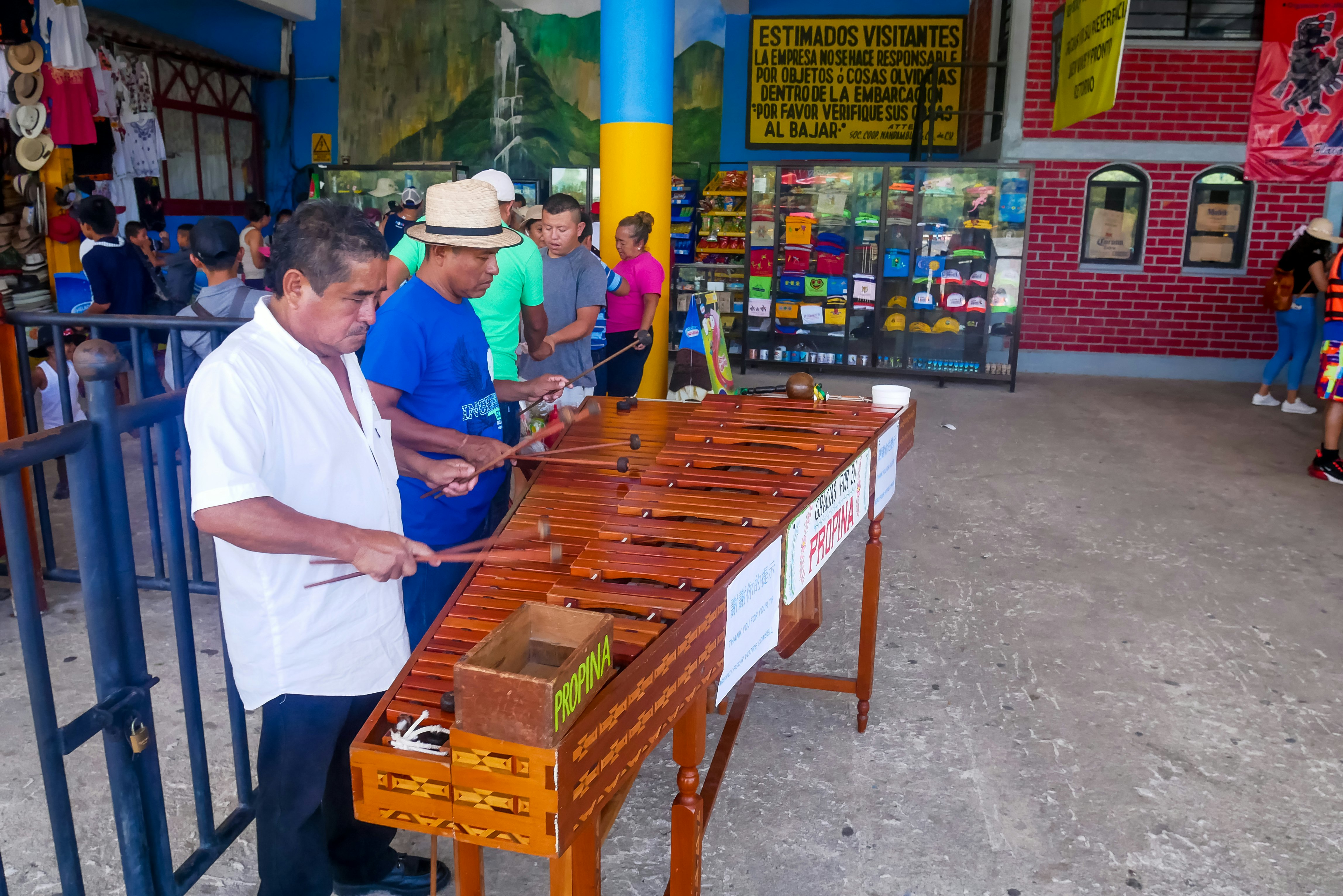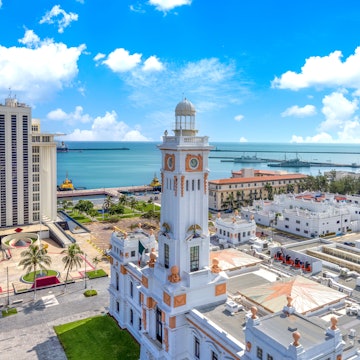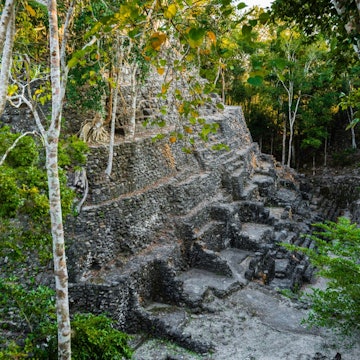

The main square and cathedral in San Cristóbal de Las Casas, Chiapas, Mexico. NEKOMURA/Shutterstock
Chiapas feels different from the rest of Mexico. There were discussions about it becoming an independent state after liberation from Spanish control, and it was also the location of Mexico’s biggest uprising in the modern era. Aside from its unique Indigenous culture, Chiapas is place of thundering waterfalls, yawning gorges, and off-grid pre-Hispanic ruins amid the tangled rainforest.
The state receives only a trickle of visitors, but intrepid travelers are frequently rewarded with crowd-free wonders and authentic cultural interactions around the charming traditional towns and highland villages. The Chiapas Highlands still retain one of the richest veins of Indigenous culture in Mexico. Around rustic Comitán and San Cristóbal de Las Casas, you’ll likely overhear Maya languages such as Tzeltal, Tzotzil or Chuj being spoken as frequently as Spanish. While political tensions do occasionally flare up, it is generally safe to travel around the region. These are the top things to do while exploring Chiapas.

1. Savor a regional food journey
Comitán de Domínguez is spearheading the rise of Chiapas as one of Mexico’s unique food regions, in part because Chiapas' variety of ecosystems produces a wide array of ingredients for creative chefs to play with. Maize naturally features heavily in many of the city’s bespoke dishes, such as chinculguajes, thick maize tortillas stuffed with beans, cilantro and chili, and pozol de cacao o cacahuate, a thick mixture of masa (cornmeal dough), water and cacao or peanuts.
Other delicious dishes worth trying include pan compuesto, a round torta (sandwich) with chicken, pickled beets, carrots and a sprinkle of fresh cheese, and cascara preparada, a massive rectangular wheat puff generously topped with cheese, corn, chili and cream. For a more substantial meal, try hueso Comiteco (aka chamorro) – pork leg (with bone included), which is slow-cooked in a sweet and sour gravy. Comitán even has its own regional take on mezcal called Comiteco. It is concocted with agave Americana (aka maguey) and piloncillo (cooked sugarcane), giving it floral notes and a honeyed sweetness.
Some favorite spots to try in Comitán include Comiteca 1948 (which has a great vegetarian selection), Mercado San José, a hip and atmospheric food hall with a glass ceiling and children’s play area, and Restaurante Macharnudas, with a plaza view upstairs. For the possibility of a meal soundtracked with live marimba music, try Camino Secreto.
Planning tip: Mexico isn’t usually friendly to plant-based diets but in San Cristóbal de las Casas, you’ll be spoiled for choice. Try its Mercado Municipal for a closer look at local life – and an assault on the senses.

2. Get a feel for daily life in Comitán
Comitán’s historic center is compact and walkable, overflowing with small museums and pretty plazas. Explore the squares and churches of the historic core to get a feel for daily life here. Start at Parque Central Benito Juárez, with its trees, flowerbeds and an ornate pagoda at its core. The square is a hive of activity on weekends and evenings, when artisans set up crafts stalls and street vendors sell steaming tacos. Next, wander over to the striking Iglesia de Santo Domingo, which gleams banana yellow. Dating back to the 16th and 17th centuries, the church is distinguished by the unusual blind arcading on the lower half of its tower. Next door, the former monastery now serves as the Centro Cultural Rosario Castellanos. Enter the courtyard to see its impressive murals.
Continuing east and past the Museo Arqueológico, work your way north for three blocks to reach Parque de la Pila. Terracotta-roofed houses flank the cobblestoned streets of La Pila, the oldest neighborhood in Comitán, while older buildings on the square are arcaded with wooden balconies above. The district’s crown jewel is the Templo de San Caralampio, an apricot- and coral-colored neoclassical church, built in 1852 to commemorate its namesake, the patron saint of Comitán. Return via the crumbling Mercado Primero de Mayo, with its mountains of colorful fruit and vegetables, and continue southeast for two blocks to Centro Cultural Rosario Castellanos to learn about Chiapas’ most famous writer.
Detour: Just south of the main square is Casa Museo Dr Belisario Domínguez, dedicated to Comitán’s hero – a doctor, the city’s mayor, a senator and a prominent political activist assassinated during the Mexican Revolution. The museum, converted from his family home and medical practice, provides fascinating insights into what life in Chiapas was like in the early 20th century.

3. Wander around picturesque alpine lakes
Hugging the Mexico–Guatemala border is Parque Nacional Lagunas de Montebello, a pristine lake district some 60km southeast of Comitán. Featuring 59 small lakes of varied hues – a decorator’s swatch of emerald greens and iridescent blues surrounded by temperate pine and oak forests – the landscape here is gloriously free from development.
The main settlement is the Chuj-speaking village of Tziscao, where you can buy your national park ticket. Keep it handy as you’ll be asked to show it at regular junctures. Getting beyond the village is difficult without your own transportation. Tuk tuk (moto taxi) drivers wait at the village entrance and will offer to take you on a tour of the national park for around 250 Mexcan pesos (M$) per person. Be sure to agree on a duration and itinerary before starting out.
Head to the jade-green Lago Internacional first, where you can wander freely across the border, marked by a white obelisk, into Guatemala. Pretty Lago Pojoj, 2km north of Tziscao, is over 700m deep. You can rent little cork rafts or kayaks here for around M$200, with life vests provided, to paddle out to Isla de las Orquídeas, an island covered in orchids. It also has a great swimming beach. Continuing west, you’ll come to Cinco Lagos, a cluster of five spectacular lakes nestled in the pits of a steep-sided cluster of pine-clad mountains. Three of the lakes are visible from the road, but you can head down a path from the roadside food stalls to take a boat across to the other side of Lago Tinto, where there’s a short sendero (path) through the forest to see the other two.
The much larger Lago Montebello also has kayaks available to rent and is popular with locals for swimming. There are some horse trekking trails through the forest to smaller, secluded lakes from here.
Planning tip: If you plan to spend the whole day, or stay in cabins here overnight, it’s worth asking your moto taxi driver to include Lagos de Colores in the itinerary, the largest being the emerald Lago Encantada. There are some simple restaurants and a parking lot beside the eerie Laguna Ensueño.

4. Move to the Marimba in Tuxtla Gutiérrez
The marimba’s roots aren’t American at all. The prototype of the modern instrument originated in sub-Saharan Africa, with similarities seen in instruments from and around Ghana. By the time it had reached Chiapas, most likely brought over with enslaved peoples, the marimba began to evolve into the complex instrument it is today. It's designed to be played without accompaniment from other instruments, and you’ll commonly see bands of two or more marimba players, although there are no fixed rules in musical creativity.
Marimba is also popular in Guatemala, although Chiapas is the epicenter of the art form in Mexico, with Tuxtla Gutiérrez – 59km west of San Cristobal – being the instrument’s unofficial capital. You’ll likely hear plenty of marimba here. No restaurant seems complete without one. The alegres are particularly fun, often sounding like a Caribbean Mario Brothers soundtrack.
The Museo de la Marimba has collection of antique marimbas, which demonstrate how this unusual and complex wooden percussion instrument evolved, as well as galleries dedicated to the marimba’s great players and makers. If you’re lucky, you may even catch an impromptu performance.
Planning tip: Every night of the year, but particularly from 6pm to 8:30pm Wednesday to Sunday, free marimba concerts are held in Tuxtla Gutiérrez’ lush Parque de la Marimba grounds, and everyone is invited to dance around the central pavilion. On weekends, it feels like the whole city shows up here for the outdoor dance party.


5. Be amazed by Chiapas’ grand canyon
On the northeast edge of Tuxtla Gutiérrez lies the Cañón del Sumidero, which reaches a depth of up to 1000m. The vertiginous canyon walls frame the jade-green waters of the Río Grijalva below. Geologically, the canyon was created around the same time as the Grand Canyon in the US. Although the Cañón del Sumidero only measures a mere 25km in length, it is a brilliant landscape of forested banks and sheer escarpments laced with trickling waterfalls.
You can head to one of the many panoramic viewpoints on the canyon’s rim, but the most popular option is to take a lancha (motorboat) tour along the river. Boats depart from the pier in Chiapa de Corzo or the Embarcadero Cahuaré, 5km east of Tuxtla. Although Cahuaré is closer to Tuxtla, boats depart much more frequently from Chiapa de Corzo. The 2-hour journey whisks you deep into the canyon, alongside massive cliffs and past tiny islets where endangered species thrive. As you glide on the waters, look out for flocks of cormorants, egrets fishing, turtles gliding in the water, and crocodiles sunbathing on the riverbank.
Tours visit a series of peculiar rock formations, including the Cueva de los Colores, a craggy cave naturally coated in a shade of pastel pink thanks to the magnesium that filtrates into the rock stack; Árbol de Navidad, where during the rainy season a 106m waterfall cascades over thick hanging moss, resembling a shimmering Christmas tree; and the Ruins of Berlin, built by the ancient Chiapa people and named after German explorer Heinrich Berlin, who gave Sumidero its name in 1946.
Planning tip: Though views from the water are stunningly beautiful, the canyon rim boasts the most dramatic and staggering vistas, so you might consider a road trip along Calzada al Sumidero. Renting a car or hiring a taxi from Tuxtla are your best options, or try a day tour that includes stops at the lookouts.

6. Admire Indigenous crafts in the Chiapas Highlands
The outstanding Indigenous artisans of the Chiapas Highlands are some of the most skilled in the country, and San Cristóbal is where you’ll find the highest quality huipiles (sleeveless tunics), weavings and blankets. For a crash course in Indigenous textiles, head to the Centro de Textiles del Mundo Maya, which showcases over 500 pieces of handwoven textiles from Maya communities throughout Mexico and Central America.
Afterward, you'll find pleny of great shops to explore, including Sna Jolobil women’s weaving cooperative, which exhibits and sells some of the very best huipiles, rugs and blouses in town. Selling pieces at the upper end of the price scale, Kuxul Pok’ was founded by Alberto Lopez Gomez, whose work has been shown at New York Fashion Week. For blankets, shawls and handicrafts produced by more than 20 Maya communities, stop by Folklora. A few blocks away you'll find El Camino de los Altos, a collaboration between French textile designers and 160 women from Indigenous communities, which sells clothing, accessories and housewares. When shopping for handicrafts, keep in mind that the originals are always unique, and no two pieces are alike.
Detour: You can also visit various artisan workshops and women’s cooperatives found throughout the village of Zinacantán.


7. Tour an array of palaces, ball courts and mighty pyramids
Palenque is among Mexico’s most important archaeological sites. The array of ruins, many of which can still be climbed, are dwarfed by thick rainforest on all sides. As you explore the earthy trails and mossy steps, bear in mind that less than 10% of this marvelous UNESCO World Heritage Site has been excavated.
From the main entrance gate, follow the uphill path and take the first right into Plaza Central, where you’ll immediately get a sense of the site’s wonder. The first structure is the Templo de la Calavera, which stands against a backdrop of tangled rainforest, hanging lianas and squawking birds. It is named after the relief carving at the base of the upper temple structure, which you can only see if you stand back.
Walk on to explore Templo XIII, known as the Tumba de la Reina Roja. It's believed to be the burial tomb of Ix Tz’aka’ab Ajaw, who was called the Red Queen due to red cinnabar trousseau coating her remains. Other highlights include Templo de las Inscripciones, the Maya world’s largest-known stepped pyramid; El Palacio’s 15m-tall, multi-story Observation Tower, the only one of its kind in the Maya world; and Juego de Pelota to the north of El Palacio, where a game played with solid rubber balls and stone hoops served as a religious metaphor for the struggle between contrary forces.
No vehicles can pass the Palenque Centro de Visitantes gate, 3.5km from the ruins. At the two connected windows, you can purchase a national park ticket for M$109 and a separate archaeological zone ticket for M$100. You then pass through that gate to the colectivo (shared van shuttle) zone, where you can either get a return colectivo ticket (M$60 wristband) or choose to walk (it’s worth paying the extra fee).
Planning tip: Allow at least half a day to properly explore Palenque ruins. Arrive 10 minutes early to be on the first colectivo to see the morning mist wrap the pyramids in a glorious haze, but avoid visiting on a Sunday as it can get crowded. Also note that food options are limited to a few cafeterias by the upper entrance and no drinking water is available.
This article was adapted from Lonely Planet’s Mexico guidebook, published in October 2025.
















